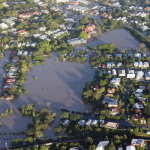

Lost in a series of higher-profile actions concerning his Administration’s climate change initiatives, President Obama’s Executive Order on Floodplain Management will have a profound impact on any future federally-funded transportation projects.
Executive Order (EO) 13690, awkwardly titled: “Establishing a Federal Flood Risk Management Standard and a Process for Further Soliciting and Considering Stakeholder Input” amends a long-standing EO on Floodplain Management. President Carter issued EO 11988 in 1977, which required federal departments and agencies to avoid, to the extent possible, “the long- and short-term adverse impacts associated with the occupancy and modification of floodplains…” In short, pursuant to EO 11988, the federal government was supposed to consider the flooding implications of any actions and to determine if there were practicable alternatives to development in or near floodplains.
Almost 40 years later, EO 13690 establishes a revised Federal Flood Risk Management Standard (FFRMS) for federally-funded projects. Importantly, the scope of this new EO deals not only with projects proposed and developed by federal agencies, but also those funded and/or approved by federal agencies. As summarized in the revised EO, the intent behind this action is clearly to “ensure that projects funded with taxpayer dollars last as long as intended.”
 In light of President Obama’s Climate Action Plan and other informal Administration actions designed to promote the resiliency of federally-funded projects, the EO dramatically amends the previous definition of a floodplain. The 1977 EO had established a floodplain to include, at a minimum, “that area subject to a one percent or greater chance of flooding in any given year.” This definition is now substantially broadened. The new EO proposes to amend Section 6(c) of EO 11988 to state that a floodplain shall be:
In light of President Obama’s Climate Action Plan and other informal Administration actions designed to promote the resiliency of federally-funded projects, the EO dramatically amends the previous definition of a floodplain. The 1977 EO had established a floodplain to include, at a minimum, “that area subject to a one percent or greater chance of flooding in any given year.” This definition is now substantially broadened. The new EO proposes to amend Section 6(c) of EO 11988 to state that a floodplain shall be:
-
The elevation and flood hazard area that result from using a climate-informed science approach that used the best-available, actionable hydrologic and hydraulic data and methods that integrate current and future changes in flooding based on climate science.
-
The elevation and flood hazard area that result from using the freeboard value, reached by adding an additional 2 feet to the base flood elevation for non-critical actions and by adding an additional 3 feet to the base flood elevation for critical actions.
-
The area subject to flooding by the 2 percent annual chance flood, or
-
The elevation and flood hazard area that result from using any other method identified in an update to the FFRMS.
To stress the scope of this revised EO, the term “critical action” is further defined to include “any activity for which even a slight chance of flooding would be too great.” Given the breadth of that definition, it is hard to imagine any significant highway or bridge project not qualifying as “critical,” especially if the facility serves in any way as a major evacuation route. The same could be said for a major transmission line or pipeline that serves as an important source of energy.
If implemented as currently proposed, EO 13690 would likely compel infrastructure project proponents to expand the reasonable range of alternatives under NEPA to reflect more resilient facilities from an engineering perspective. For example, bridges in certain areas of the country that need repair may, in some cases, now face replacement if floodplain data requires additional clearance. While the EO claims to reflect a desire to protect taxpayer investment in the long run, there could well be additional costs incurred in the short-term to meet these proposed revised standards.
Without a doubt, EO 13690 is an important piece of the climate change puzzle being pursued by this Administration before it leaves office in January 2017. The EO reflects many of the key components of the President’s climate strategy, from recognizing how a changing climate and potential sea rise could impact infrastructure development, to reliance on current “best available science,” to incorporation of a policy of resilience to higher standards than previously used. It could be argued that this new EO will have a more profound impact on governmental action over the next decade than even proposed sweeping GHG regulations, as those proposals face inevitable legal challenges that will drag on for years.